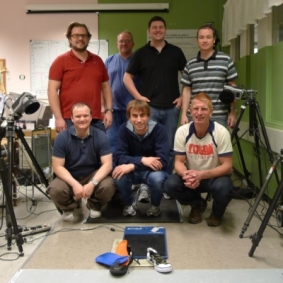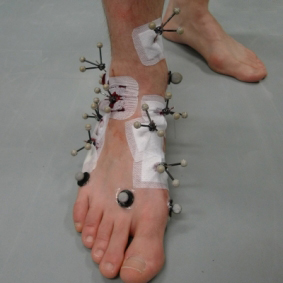Invasive Foot Biomechanics
Biomechanical models of the foot are generally reduced to simplified representations of this complex structure. The major limitation resulting from these simplified models is the inability to correctly attribute motion to the correct anatomical articulation, particularly for the smaller and distal segments within the foot.
In order to accurately monitor intrinsic kinematics in vivo, a collaboration of the Karolinska University Hospital Huddinge, Sweden, the University of Salford, England, and the ETH Zurich, Switzerland, has been launched in 2004. Current research questions are related to (i) the magnitude of the skin movement artefact when ankle movements are registered non-invasively, (ii) the effects of different foot orthoses on kinematics and plantar pressure, (iii) the effect of different midsole modifications on the kinematics, (iv) the correlation between plantar pressure data and intrinsic foot kinematics (in cooperation with the Chemnitz University of Technology, Germany), (iv) the validation of functional foot axes, and (v) the evaluation of the contact surfaces of the ankle joint during walking and running.
Selfdrilling, 1.6 mm diameter pins are inserted under local anesthetic and fluoroscopy guidance into the bones of interest. Free movement of pins relative to each other and lack of skin impingement is controlled by passive and active foot movements immediately after all pins are inserted. If free pin motion is restricted by the skin, the incision surrounding the relevant pin is extended. Custom made marker arrays were firmly attached to the protruding ends of the pins. Subjects familiarize themselves with walking with pins inserted in the foot. Thereafter, the motion tracking during different movement tasks starts.
Publications
Wolf P, Stacoff A, Liu A, Nester C, Arndt A, Lundberg A, Stuessi E (2008)
external page Functional units of the human foot.
Gait & Posture 28: 434-441.
Lundgren P, Nester C, Liu A, Arndt A, Jones R, Stacoff A, Wolf P, Lundberg A (2008)
external page Invasive in vivo measurement of rear, mid and forefoot motion during walking.
Gait & Posture 28: 93-100.
Nester C, Jones RK, Liu A, Howard D, Lundberg A, Arndt A, Lundgren P, Stacoff A, Wolf P (2007)
external page Foot kinematics during walking measured using bone and surface mounted markers.
Journal of Biomechanics 40:3412-3423.
Arndt A, Wolf P, Lui A, Nester C, Stacoff A, Jones R, Lundgren P, Lundberg A (2007)
external page Intrinsic foot kinematics measured in vivo during the stance phase of slow running.
Journal of Biomechanics 40:2672-2678.

